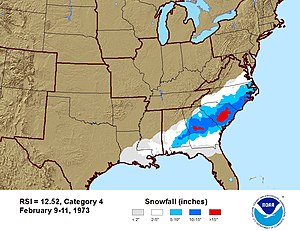Contents

The regional snowfall index (RSI) is a system used by NOAA to assess the societal impacts of winter storms in the United States. The scale is a replacement for the Northeast snowfall impact scale (NESIS) system, which was used for winter storms just in the Northeastern United States; Regional Snowfall Index assesses winter storm impacts in the six easternmost regions of the United States instead of just the Northeast. Since its initiation, the NCDC has assigned RSI values to nearly 600 winter storms since 1900.
Storms are ranked from category 0 "nuisance" to category 5 "extreme" on the scale. A category 4 winter storm on the RSI scale is classified as "crippling". The impact of the storms is assessed in six different regions of the United States: the Northeast, Northern Rockies and Plains, Ohio Valley, South, Southeast, and Upper Midwest.[1] A category 4 "crippling" ranking is indicated by a numerical score between 10 and 18 on the scale.
Out of the nearly 600 historical winter storms assessed since 1900, only 74 storms have been given a category 4 or above ranking, 48 of which were category 4 storms. The highest ranking category 4 winter storm is the March 2–8, 1915 United States blizzard, which had an RSI of 17.67. The most recent storm to receive a category 4 ranking is the December 2022 North American winter storm, which scored an RSI value of 11.49. The following list orders the category 4 storms chronologically.[1][2][3]
List of category 4 events
This list includes all winter storms which had a maximum RSI value in the category 4 range. Storms that ranked as a category 4 in some regions but ranked as a category 5 in one or more other regions are not included in this list.[4][2]
| Year | Date | Max. RSI | Region |
|---|---|---|---|
| 1900 | February 26 – March 3 | 15.65 | Northeast, South |
| 1902 | February 13–19 | 10.16 | Southeast |
| 1902 | March 3–6 | 12.19 | Northeast, South |
| 1910 | February 16–18 | 11.34 | Ohio Valley |
| 1913 | November 7–11 | 16.09 | Ohio Valley |
| 1915 | March 2–8 | 17.67 | Northern Rockies and Plains, South |
| 1918 | December 21–26 | 10.61 | South |
| 1929 | December 16–21 | 10.62 | Upper Midwest |
| 1930 | December 13–18 | 13.97 | Southeast |
| 1933 | April 18–22 | 12.69 | Northern Rockies and Plains |
| 1936 | February 6–8 | 11.26 | Southeast |
| 1947 | January 27–31 | 10.18 | Upper Midwest |
| 1947 | February 27 – March 4 | 10.63 | Northeast |
| 1949 | January 1–6 | 15.79 | Northern Rockies and Plains |
| 1951 | March 9–17 | 12.97 | Upper Midwest |
| 1955 | April 3–6 | 16.93 | Northern Rockies and Plains |
| 1956 | January 31 – February 6 | 13.78 | South |
| 1962 | February 28 – March 7 | 11.79 | Southeast |
| 1962 | March 5–9 | 12.66 | Southeast |
| 1966 | January 27–31 | 12.28 | Northeast |
| 1969 | December 25–29 | 10.14 | Northeast |
| 1971 | February 26 – March 6 | 10.18 | Northeast |
| 1973 | February 9–11 | 12.52 | Southeast |
| 1978 | December 28, 1978 – January 3, 1979 | 10.08 | Upper Midwest |
| 1979 | January 13–14 | 14.42 | Ohio Valley |
| 1979 | February 17–20 | 15.01 | Southeast |
| 1979 | November 17–22 | 10.81 | Northern Rockies and Plains |
| 1980 | February 5–10 | 10.55 | South |
| 1980 | February 28 – March 3 | 15.14 | Southeast |
| 1983 | February 10–13 | 14.78 | Southeast |
| 1985 | March 1–5 | 15.18 | Upper Midwest, Northern Rockies and Plains |
| 1987 | January 21–24 | 13.16 | Southeast |
| 1987 | April 2–6 | 11.21 | Ohio Valley |
| 1999 | January 2–4 | 15.30 | Upper Midwest, Ohio Valley |
| 2003 | February 14–19 | 14.67 | Northeast |
| 2004 | December 21–24 | 11.31 | Ohio Valley |
| 2005 | January 20–23 | 10.34 | Northeast |
| 2006 | March 19–22 | 14.22 | Northern Rockies and Plains |
| 2009 | March 27–30 | 14.95 | South |
| 2009 | December 16–20 | 15.71 | Southeast |
| 2010 | February 5–6 | 10.15 | Southeast |
| 2010 | February 8–13 | 12.75 | South |
| 2010 | February 10–13 | 10.07 | South |
| 2010 | February 25–27 | 15.85 | Northeast |
| 2011 | February 9–11 | 11.80 | South |
| 2014 | February 11–24 | 10.66 | Southeast |
| 2017 | March 11–15 | 10.66 | Northeast |
| 2018 | April 13–15 | 15.7 | Upper Midwest |
| 2022 | December 13-20 | 10.35 | Upper Midwest |
| 2022 | December 21–26 | 11.49 | Upper Midwest |
Listed by month
|

|
See also
- List of regional snowfall index category 5 winter storms
- List of Northeast snowfall impact scale winter storms
- List of blizzards
References
- ^ a b "Regional Snowfall Index (RSI)". NOAA: National Centers for Environmental Information. Retrieved December 26, 2020.
- ^ a b "Regional Snowfall Index and Societal Impacts". Retrieved December 26, 2020.
- ^ "NOAA Product Highlight: Regional Snowfall Index". Archived from the original on November 29, 2014. Retrieved December 26, 2020.
- ^ a b Squires, Michael; Lawrinmore, Jay; Heim, Richard; Robinson, David; Gerbush, Mathieu; Estilow, Thomas. "The Regional Snowfall Index" (PDF). American Meteorological Society. Retrieved December 26, 2020.

